Folk customs of Chinese Lunar New Year in C China
Source:Xinhua Published: 2013-2-3 9:08:14
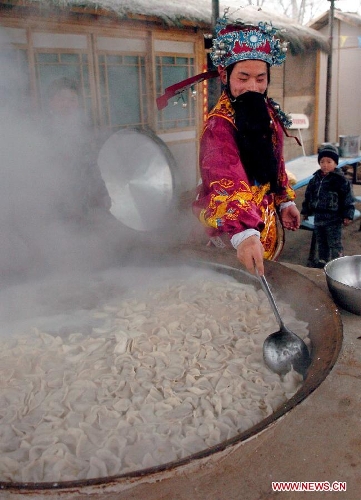
An actor acting as the Kitchen God boils dumplings for citizens during a temple fair in Zhengzhou, capital of Central China's Henan Province, January 28, 2006. In Chinese mythology, the Kitchen God is the most important of a plethora of Chinese domestic gods that protect the hearth and family. It is believed that on the 23rd day of the 12th lunar month, just before Chinese Lunar New Year he returns to Heaven to report the activities of every household over the past year to the Jade Emperor. The Jade Emperor, emperor of the heaven, either rewards or punishes a family based on Kitchen God's yearly report. (Xinhua/Wang Song)
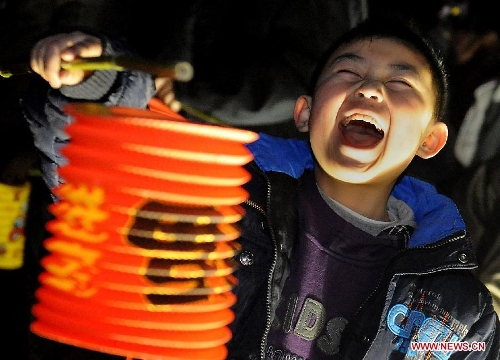
A child laughs with pleasure as he holds a newly-bought festive lantern in Zhengzhou, capital of Central China's Henan Province, February 1, 2011. Chinese children are usually given festive lanterns to celebrate the Spring Festival or Chinese Lunar New Year. (Xinhua/Wang Song)

Younger generation bow to their elders to extend their Spring Festival greetings at a temple fair in Zhengzhou, capital of Central China's Henan Province, January 28, 2006. It is a custom for younger generation to pay New Year call to elders during the Spring Festival. The elderly, in return, would give the young Yasui money meaning "money warding off evil spirits."

Villagers brew rice wine with traditional technique at a yard in Zhengzhou, capital of Central China's Henan Province, January 28, 2006. People in many villages in central China region still follow the custom to brew rice wine by themselves beforehand so as to drink the wine on the Chinese New Year's eve. Chinese people who live in the Central China region have formed various traditions to celebrate the Chinese Lunar New Year. (Xinhua/Wang Song)
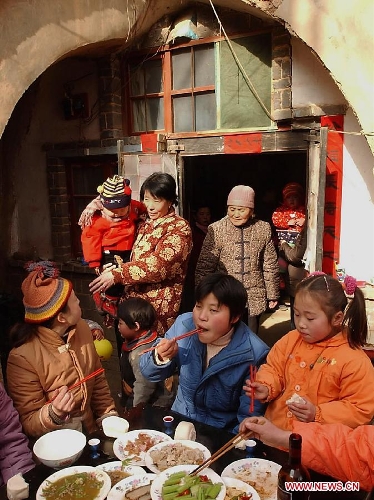
A family gather to have a family-reunion dinner outside their cave dwelling in Qucun village of Shaanxian county, Central China's Henan Province, February 1, 2003. Different from the other parts of China in which people have family reunion dinner on the Chinese New Year's eve, people living in the Central China region have the family banquet at the noon of the first day of the lunar month. Chinese people who live in the central China region have formed various traditions to celebrate the Chinese Lunar New Year. (Xinhua/Wang Song)

A vendor sells a traditional Spring Festival food, namely "thick stick bun of eastern Henan "on a street in Shangqiu city, Central China's Henan Province, January 12, 2003. Chinese people who live in the Central China region have formed various traditions to celebrate the Chinese Lunar New Year. (Xinhua/Wang Song)
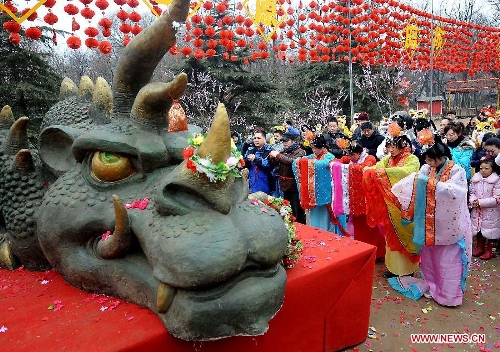
People gather to worship "Nian," a beast in Chinese mythology which comes out of hiding to attack people around Chinese Lunar New Year, at a temple fair in Zhengzhou, capital of Central China's Henan Province, February 10, 2010. Chinese people who live in the Central China region have formed various traditions to celebrate the Chinese Lunar New Year. (Xinhua/Wang Song)

A grandma holds her grandchild who wears a traditional tiger hat as they head for a New Year fair in Tuocheng county, Central China's Henan Province, January 20, 2004. People living in the Central China's region usually follow a tradition to wear new clothes and children are dressed with tiger hats or shoes to ward off evil spirits during the Spring Festival or Chinese Lunar New Year. (Xinhua/Wang Song)

People carry lanterns during the 29th day of the 12th lunar month at a plaza in Zhengzhou, capital of Central China's Henan Province, February 1, 2011. It is a custom for people living in the Central China region to carry lanterns on the 29th day of the 12th lunar month outdoors to pray for good luck. Chinese people who live in the Central China region have formed various traditions to celebrate the Chinese Lunar New Year. (Xinhua/Wang Song)

Art troupes and people gather to participate in a New Year parade in Zhengzhou, capital of Central China's Henan Province, February 14, 2010. Parades participated by local art troupes can be seen in several places in Henan during the Spring Festival or Chinese Lunar New Year period. (Xinhua/Wang Song)

A folk artist makes traditional woodblock New Year pictures in Zhuxian township of Kaifeng county, Central China's Henan Province, January 9, 2008. New Year Picture is usually made on various subjects, such as door god, conventions, carnivals, the Kitchen God, women and babies. As each Chinese New Year arrives, every family modifies its New Year picture in order to "say goodbye to the Past and welcome the Future." Chinese people who live in the Central China region have formed various traditions to celebrate the Chinese Lunar New Year. (Xinhua/Wang Song)

Performers play the dragon dance in Zhengzhou, capital of Central China's Henan Province, February 16, 2011. Folk performances are usually held from the 13th day of the first lunar month to celebrate the Spring Festival or Chinese Lunar New Year in Central China region. Chinese people who live in the central China region have formed various traditions to celebrate the Chinese Lunar New Year. (Xinhua/Wang Song)

Children watch theatrical performance at an outdoor plaza in Weihui city, Central China's Henan Province, February 6, 2003. Village theatrical performances are usually given by local troupes during the Spring Festival or Chinese Lunar New Year in Central China region. Chinese people who live in the central China region have formed various traditions to celebrate the Chinese Lunar New Year. (Xinhua/Wang Song)

Performers of a local art troupe prepare to perform stilts dance during a festive activity or "Shehuo" in Chinese at a temple fair in Huaiyang county, Central China's Henan Province, March 18, 2010. Festive activity is an ancient form of folk art, a popular comprehensive cultural activity held during the Spring Festival or Chinese Lunar New Year among people. (Xinhua/Wang Song)

People gather to commemorate Fu Hsi, a legnedary emperor of China who is regarded as an ancestor of Chinese civilization in Huaiyang county, Central China's Henan Province, March 17, 2010. The Central China region is regarded as the birthplace of Chinese civilization and people here have a tradition to attend the memorials to commemorate ancestors to pray for good fortune in the new year. Chinese people who live in the central China region have formed various traditions to celebrate the Chinese Lunar New Year. (Xinhua/Wang Song)

A bride (C) with a red cloth on the head walks along a corridor to her wedding ceremony in Zhangbian township of Shanxian county, Central China's Henan Province, February 9, 2000. People who live in the central China region usually hold wedding ceremonies during the festive Spring Festival period. (Xinhua/Wang Song)
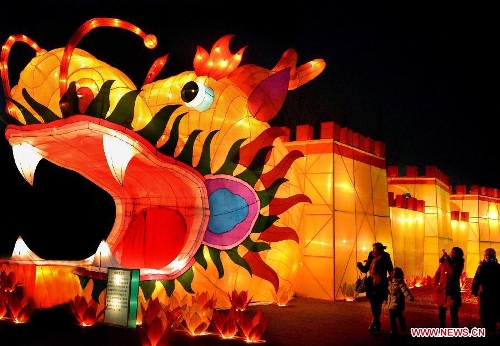
People walk past lanterns at a lantern fair in Zehngzhou, capital of Central China's Henan Province, January 26, 2012. Chinese people has a tradition to enjoy lanterns during the Lantern Festival which falls on the 15th day of the first lunar month. (Xinhua/Wang Song)

People gather to visit a New Year fair in Baofeng county, Central China's Henan Province, February 4, 2012. People living in Central China region has a tradition to visit a New Year fair, in which almost all kinds of daily commodities can be found. Chinese people who live in the Central China region have formed various traditions to celebrate the Chinese Lunar New Year. (Xinhua/Wang Song)

Chinese "blessing" written on a piece of red paper is pasted on the trunk of a tree in Huaiyang county, Central China's Henan Province, January 17, 2004. People who live in the Central China region has a tradition to paste "blessing" on doors or trees to pray for good luck in the Spring Festival or Chinese Lunar New Year. (Xinhua/Wang Song)

A young man hangs chains of firecrackers on a bank of the Yellow River in Zhengzhou, capital of Central China's Henan Province, February 3, 2005. The crackling and spluttering sound from firecrackers during the Spring Festival or Chinese Lunar New Year is expected to intimidate the Nian, a beast in Chinese mythology which comes out of hiding to attack people around Chinese New Year. Chinese people who live in the Central China region have formed various traditions to celebrate the Chinese Lunar New Year. (Xinhua/Wang Song)
Posted in: Society, China